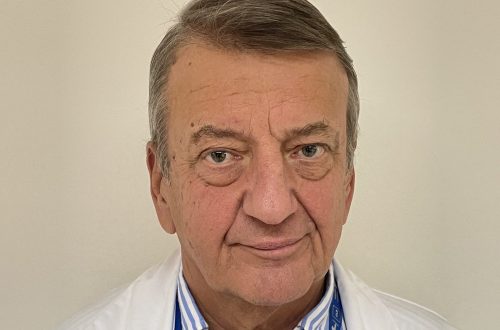Congress Newsletter 2023
The Glasgow Declaration on Sustainability in Anaesthesiology and Intensive Care: An ESAIC initiative paving the way to environmental sustainability in anaesthesiology and intensive care
This morning, during the inauguration of the Exhibition area at Euroanaesthesia 2023, right at the Dear Green Place, we signed the ESAIC Glasgow Declaration on Anaesthesiology and Intensive Care. This momentous occasion marks a groundbreaking milestone in the history of healthcare and the ESAIC community!
The healthcare sector significantly contributes to global pollution and climate change. It is concerning to note that all types of pollution produced in hospital care, if not properly treated, are released unchanged or undergo an incineration process, resulting in an environmental impact affecting water ecosystems and releasing significant CO2 emissions to the atmosphere. These emissions add to the existing Green House Gases (GHGs) responsible for climate change, exacerbating our current environmental crisis.
The World Health Organization (WHO) warns that climate change directly affects health’s social and environmental determinants. If we fail to address this issue, it is estimated that between 2030 and 2050, climate change will cause approximately 250,000 additional deaths per year worldwide. The direct damage costs to health are projected to reach a staggering USD 2-4 billion annually by 2030(1).
The healthcare sector contributed to 5.2% of global greenhouse gas emissions in 2019, with inhaled anaesthetic agents accounting for 2% of the total emissions from the health system. Furthermore, operating rooms (ORs) generate approximately 20% of all waste in a hospital. As a result, the field of anaesthesiology and intensive care has a significant role to play in reducing health systems’ carbon footprint and ensuring future environmental sustainability.
Hospital waste is a significant contributor to solid waste generation and GHG emissions. Astonishingly, hospital waste constitutes approximately 1% of a nation’s solid waste and is responsible for 2.1% of annual GHG emissions. This highlights the urgent need for sustainable waste management strategies within the healthcare sector.
Anaesthesia significantly contributes to waste generation in hospitals. It is estimated that 25% of OR waste is generated by anaesthesia-related materials. This waste includes disposable items such as masks, tubing systems, and packaging, which, if not effectively managed, can have adverse environmental consequences.
Another concerning aspect related to anaesthesia is the impact of anaesthetic drugs on global warming. The production and use of inhaled anaesthetic contributes to the overall carbon footprint of the healthcare sector. The annual carbon footprint of inhaled anaesthetic drugs globally is equivalent to the emissions produced by one million cars in just one year(2). This underscores the urgent need for sustainable practices in anaesthesia delivery.
“To address the environmental impact of hospitals and mitigate climate change, healthcare systems must adopt sustainable practices. Tackling the climate emergency has never been more of a pressing matter. Actions leading to changes affecting our daily lives must be taken now. Something specific is that we may improve environmental impact and build a better future by creating a culture which becomes an integral part of the environmental sustainability commitment and purpose of each stakeholder involved in this quest. Environmental sustainability is a crucial issue that affects us all, including the field of anaesthesiology and intensive care.” emphasised Prof. Edoardo De Robertis, MD PhD, ESAIC President 2022-2023.
The Sustainability Committee at ESAIC, established a few years ago to address the environmental impact of anaesthesiology, is currently developing a comprehensive position paper. This paper will further underscore our dedication to sustainability and provide practical steps for integrating environmentally responsible practices into our daily healthcare activities. As healthcare professionals, it is our shared responsibility to recognize the significance of reducing our environmental footprint and actively promoting sustainable practices that benefit not only our patients but also the overall health of our planet. By embracing sustainability, we can contribute to a positive change and foster a healthier future for individuals and the global community,” stated Dr Patricio Gonzalez-Pizarro, Chair of the Sustainability Committee at ESAIC.
Climate change is a defining issue for our generation. We are facing an environmental crisis in which we have a small but significant part to play. Therefore, to address this crisis the European Society of Anaesthesiology and Intensive Care (ESAIC) has developed The Glasgow Declaration on Sustainability in Anaesthesiology and Intensive Care; a roadmap to environmental sustainability within the fields of anaesthesiology and intensive care.
The ESAIC Glasgow Declaration focuses on three key areas: medication use, energy use, and circularity in processes and waste. The greatest gains in environmental sustainability can be achieved by addressing these areas. Recommendations encourage the use of anaesthetics with the lowest global warming potential, using halogenated agents at the lowest possible fresh gas flow, and stockpiling emergency-use medications with careful monitoring.
“The ESAIC Glasgow Declaration on Sustainability in Anaesthesiology and Intensive Care was written based on the European Union’s resolute commitment to addressing climate change. The European Green Deal endeavours to accomplish climate neutrality by 2050 and decrease emissions by 55% by 2030 (in comparison to 1990). The EU (European Union) is also proposing regulations to lessen the utilisation of fluorinated gases (F-gases), potent greenhouse gases contributing 2.5% of total EU greenhouse gas emissions.” said Prof. Wolfgang Buhre, MD PhD, ESAIC Incoming President 2023 and Chair of the Department of Anaesthesiology at Utrecht University Medical Centre. He adds: “This is pertinent to ESAIC since inhaled anaesthetic agents may comprise hydrofluorocarbons, which are F-gases. To ensure practicality and acceptability, the shift towards environmental sustainability must consider the timeline for developing and making available environmentally friendly alternatives for medicines, devices, and equipment.”
Having assessed the importance of environmental sustainability and the part all stakeholders can play in contributing to a better planet, ESAIC is taking a leading role, working on a portfolio of programmes. These projects, each embody environmental sustainability, integrating it into our daily activities. They focus on different ecological sustainability pillars relevant to our mission, vision, and routine as a European Organisation for our members and national societies. With the Glasgow Declaration in Anaesthesiology and Intensive Care, ESAIC will lead the change towards greener, sustainable healthcare systems.
The ESAIC sustainability strategy goes beyond drugs and anaesthetic agents, recognising and addressing the many ways hospitals and practice can affect the environment. Energy use in hospitals, particularly from heating, ventilation, and air conditioning systems (HVAC), represents a sizeable portion of overall energy consumption in ORs. Recommendations to reduce energy use include optimising HVAC settings, incorporating renewable energy sources, utilising energy-efficient lighting, and employing water-saving measures.
To address the circularity in processes and waste, the Declaration recommends considering the purchase of reusable or reprocessed equipment, avoiding single-use items without clear patient care benefits, reducing waste generation, educating staff on waste management, and implementing measures to reduce pharmaceutical pollution in sewage water.
ESAIC aims to provide leading education in sustainability to anaesthesiologists around the world so informed based decisions can be made in everyday clinical practice. In order to do so, ESAIC created a Sustainability Committee that has produced educational material published in peer-reviewed journals and in ESAIC’s website. Moreover, dedicated scientific panels on this topic have been held during ESAIC Euroanaesthesia annual congress though out the last years. But education is just one pillar of our vision for the upcoming term. Therefore independent scientific research and respectful collaboration with committed industry partners must be warranted as well in order to achieve a vision of enhanced sustainability for the benefit of our patients, our society and our planet.
“The Glasgow Declaration on Sustainability in Anaesthesiology and Intensive Care will aim to impact changing practices in how we deliver safe anaesthesia and healthcare. European countries will incorporate it into their healthcare plans, emphasising the need for multidisciplinary dialogue. It will be adapted to local contexts, and there will be comprehensive training and communication with all relevant personnel. By working together, the vision of enhanced sustainability in anaesthesiology and intensive care can be achieved for the benefit of patients, society, and the planet.” added Prof. Wolfgang Buhre MD PhD, ESAIC Incoming President 2023, President 2024-2025.
Dr. Paul McConnell, Chair of Ethics at ESAIC stated that “Anaesthesia has been one of the great success stories of modern medicine, allowing what was once thought impossible to happen, by placing innovation and patient safety at its heart. We know what good we have accomplished, but now we recognise what cost our achievements may have come at. We stand at an environmental crossroads, and we know what we must do. The Glasgow Declaration represents a commitment to work in partnership with practitioners, industry, and our patients towards a safer sustainable future and the vision of a better tomorrow.”
The Glasgow Declaration on Sustainability in Anaesthesiology and Intensive Care was officially signed at the Dear Green Place’s inauguration during the exhibition opening ceremony at Euroanaesthesia 2023 on June 3, 2023, in Glasgow, Scotland.
The ESAIC Glasgow Declaration demonstrates the importance of making our care more sustainable. The declaration calls for, and heralds in a new age of environmentally friendly alternatives for medicines, devices and equipment used in anaesthesiology and intensive care as well as a change in culture and approach in how we view our hospital systems.
By fostering a culture of sustainability, the ESAIC envisions a future where the environmental impact of anaesthesiology is minimised, resources are used efficiently, and patient care is aligned with environmental stewardship. Through ongoing initiatives, collaboration with stakeholders, and the dissemination of best practices, the ESAIC aims to empower anaesthesiologists to be agents of change, contributing to greener and more sustainable healthcare.
That future starts now!
About the authors of the Glasgow Declaration on Sustainability in Anaesthesiology and Intensive Care and KOLs quoted on this article:
- Prof. Edoardo De Robertis (IT), MD PhD, ESAIC President 2022-2023, Director of Anaesthesia and Intensive Care at the University of Perugia.
- Prof. Wolfgang Buhre MD PhD (NL), ESAIC Incoming President 2023, President 2024-2025, Chair of the Department of Anaesthesiology at Utrecht University Medical Centre (UMCU), Professor of Anaesthesiology at Utrecht University.
- Dr. Patricio Gonzalez-Pizarro (ES), MD, PhD, Hospital Universitario La Paz Paediatric Anaesthesia and Critical Care, also acting as Chair of the Sustainability committee at ESAIC.
- Dr. Paul McConnell MB ChB(hons) LLM FRCA EDIC FFICM , Chair of Ethics at ESAIC Senior Honorary Clinical Lecturer, University of Glasgow, Consultant in Anaesthesia and Intensive Care Medicine, Royal Alexandra Hospital, Paisley.
References
- World Health Organization. (2021). Climate change and health. Retrieved from https://www.who.int/news-room/fact-sheets/detail/climate-change-and-health.
- McGain F, Muret J, Lawson C, Sherman JD. Environmental sustainability in anaesthesia and critical care. Br J Anaesth. 2020 Nov;125(5):680-692. doi: 10.1016/j.bja.2020.06.055. Epub 2020 Aug 12. PMID: 32798068; PMCID: PMC7421303.
- Centers for Disease Control and Prevention. (2021). Managing and Reducing Waste: A Guide for Health Care Facilities. Retrieved from https://www.cdc.gov/nceh/ehs/Docs/Managing_Reducing_Waste_HC.pdf
- Shaw, A., McMurray, R., & Taylor, D. (2017). Environmental impact of inhalational anaesthesia. BJA Education, 17(5), 171-176.
- Sulbaek Andersen, M. P., Nielsen, O. J., Wallington, T. J., Karpichev, B., Sander, S. P., & Wallington, T. J. (2017). Inhalation anaesthesia: A contribution to global warming. PloS one, 12(6), e0178095.
- Romanello M, Di Napoli C, Drummond P, et al. 2022. The 2022 report of the Lancet Countdown on health and climate change: health at the mercy of fossil fuels. The Lancet 400(10363): 1619-54
- Romanello M, McGushin A, Di Napoli C, et al. 2021. The 2021 report of the Lancet Countdown on health and climate change: code red for a healthy future. The Lancet 398(10311): 1619-62










